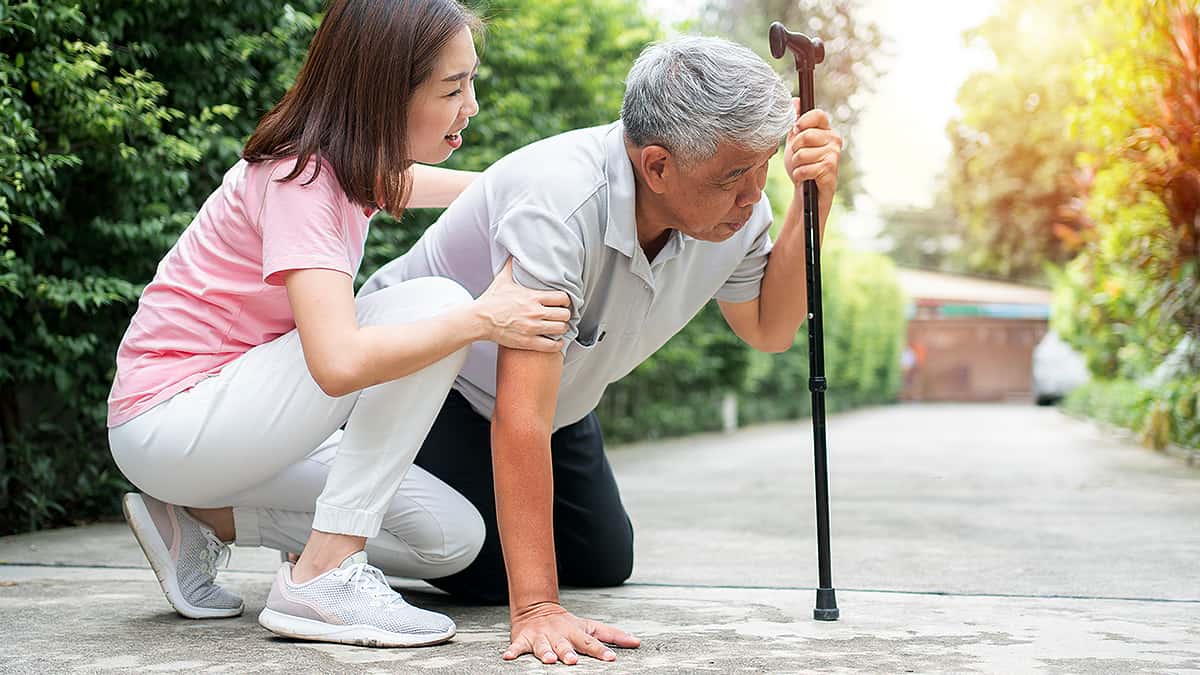How to Prevent and Reverse Sarcopenia
Physical Health

Is losing muscle just a normal part of aging? For some people, a drop in muscle mass and strength can be a serious health problem known as sarcopenia. People with this condition may be more at risk for falls and can have trouble performing daily activities. There are many risk factors for sarcopenia. Some of these, like not getting enough exercise, can be prevented. Additionally, muscle loss can be reversed. Strength training, a healthy diet, supplements, and may all help treat sarcopenia.
What is Sarcopenia?
People with sarcopenia have low levels of muscle mass (the total amount of all muscles found in your body). They also have decreased muscle strength or function, which can be measured using things like walking speed or handgrip strength. This loss of muscle happens over time, usually due to aging.
The process of losing muscle starts happening earlier in life than you may think. After a person turns 30, they begin to lose about 3-8% of muscle per decade. This process speeds up even further when a person is in their 60's. By the time someone reaches their 80's, they may have lost up to half of their original muscle mass.
As many as one in three people over the age of 60 has sarcopenia. While sarcopenia is usually seen in older people, it may also be seen in younger people as well. For example, people with inflammatory diseases are more likely to develop sarcopenia.
Why is Sarcopenia a Problem?

Sarcopenia can lead to multiple other physical and mental health issues. People with this condition may be more likely to get broken bones. They may also walk more slowly, which can be a sign that a person has a higher risk of sickness and death. Sarcopenia may also lead to disability and a greater risk of falls.
People living with sarcopenia also say that they experience many other physical and mental issues as a result of their condition, such as:
- Trouble standing
- Balance problems
- Muscle aches and pains
- Feeling afraid of being injured
- Feeling embarrassed about their health
- Feeling lonely or meeting up with friends and family less often
Many people with sarcopenia have a harder time meeting their own needs. Sarcopenia can make it harder to do everyday tasks such as cleaning up around the house, showering, and driving. This may mean that they are less able to live independently.
Finally, people with sarcopenia may have a shorter life expectancy. Focusing on sarcopenia risk factors and working to build more muscle can help you live a longer, healthier life.
How Do You Know if You Have Sarcopenia?
If you think you may have this condition, talk to your doctor. Your doctor may run several tests in order to make a diagnosis, such as:
- Imaging scans in order to see how much muscle you have throughout the body
- Tests that test measure how strongly you can grip, in order to see how strong your muscles are
- Tests that measure how quickly you can walk or climb stairs, in order to see how well your muscles work
If your doctor thinks you may have sarcopenia, they can help you come up with a plan to prevent further muscle loss and even build new muscle.
Preventing Sarcopenia
Sarcopenia has been linked to several risk factors. For example, this condition becomes more common with age. Additionally, up to 30% of your risk of sarcopenia may be linked to genes passed down from your parents. While you can't control your age or your genetics, there are other risk factors that you can change.
Exercise

Not getting enough physical activity can increase your chance of developing sarcopenia. Getting more exercise can reduce your risk and lead to more muscle strength. When healthy adults undergo strength training, they build muscle and can perform everyday tasks more easily.
Many different forms of physical activity can help. Some types of exercises that have been used in studies to help protect against sarcopenia include:
- Resistance training: This type of workout, also known as strength training, helps build up muscle. It includes exercises that use weights, resistance bands, or body weight.
- Functional training: This type of movement trains people to better carry out everyday life activities. Functional training strengthens multiple different muscle groups and helps them work together better.
- Aerobic exercise: Exercises in this category increase your heart rate and make you breathe faster. Aerobic exercise, or cardio, includes activities like running, walking, and swimming.
Diet
Nutrition also plays a key role. People who eat more protein and get more vitamin D are less likely to get sarcopenia. If you want to lower your chance of being diagnosed with this condition, eating a balanced diet where you're getting enough of these nutrients may help.
Other Factors
Certain diseases may also lead to more muscle loss. These include heart disease and cancer. Factors like eating a healthy diet, quitting smoking, and not drinking alcohol heavily can help with your heart health. These healthy habits can also reduce cancer risk, and in turn, may lower your chance of getting sarcopenia.
Other risk factors of sarcopenia include:
- Changes in hormones
- Damage to the nervous system
- Inflammation
- High levels of fat in the liver
- Not getting good enough nutrition
These health issues can often be detected during regular doctors' visits. Talk to your doctor about how often you should have check-ups and health screenings.
Sarcopenia Treatments
There are no official treatments that the FDA has approved for sarcopenia. However, there are several things that people with this condition can do in order to build up more muscle and improve their strength.
Exercise
Many different types of exercise can help people with sarcopenia. However, one of the best types of workouts may be progressive resistance training, or PRT. During PRT, people focus on building up strength using things like resistance bands, free weights, or weight machines. As a person gets stronger, the amount of weight or resistance used is slowly increased.
In one set of studies, researchers found that PRT helped older people gain an average of 2.4 pounds of muscle. In another analysis of 121 clinical trials that included 6700 people, researchers found that PRT could help people:
- Walk faster
- Get out of a chair more quickly
- Go up steps more easily
- Gain stronger muscles
- Have less arthritis pain
- Have enhanced physical ability
- Complete daily activities like cooking or bathing more easily
Studies have found that performing more repetitions of an exercise or doing higher-intensity exercises can lead to more improvements in building muscle for older adults. However, too much exercise can lead to injury, so it's important to start slow. Talk to your doctor before beginning a new workout program, especially if you have other health conditions. Your doctor can give you recommendations for an exercise plan that is best for you.
You can start using PRT by making a habit of strength training. Experts recommend that older adults perform exercises that are focused on muscle strength two times per week. Try taking a class geared towards seniors at a local gym, community center, or online. You can also try tracking your exercise with activity logs or with smartphone apps. Additionally, PRT is not the only type of exercise that can improve your health. Many people living with sarcopenia have found that exercises like cardio, physical therapy, and pool exercises have helped them improve their flexibility and strength.
Nutrition

Because eating low levels of protein has been linked to sarcopenia, it's important for older adults to make sure they are getting enough of this nutrient. Eating more protein can help older adults gain more mass and increase their life expectancy. Experts recommend getting 25-30 grams of protein at each meal. Foods that contain a lot of protein include meat (beef, pork, sausage), poultry (chicken, turkey, duck), seafood, eggs, beans, lentils, nuts and nut butters, seeds, and soy foods (tofu, tempeh, edamame).
A Combination of Better Nutrition and Exercise Is Even More Effective
Getting enough nutrients, and especially eating enough protein, is important if you are also getting more exercise. Eating a nutritious diet can help exercise be more effective for people living with sarcopenia.
In one clinical trial, researchers tried to help older, frail nursing home residents build muscle. Participants who exercised had some improvements in muscle strength and were able to walk faster and climb stairs more easily. People who got better nutrition in addition to being put on an exercise program had even larger improvements.
Other studies have had similar findings. Another clinical trial showed that when older adults got aerobic exercise, their bodies were better able to absorb nutrients and deliver those nutrients to the muscle. People who used a combination of healthy eating and exercise built more muscle than people who got better nutrition but didn't exercise.
Supplements
Sometimes, it's hard to get all of the nutrients you need from diet alone. Taking supplements may help you make sure you are reaching your nutritional goals.
One easy way to get extra protein is by taking high-protein supplements. Many of these supplements contain essential amino acids. Amino acids are the building blocks of protein, and "essential" amino acids are ones that your body can't make itself – it needs to get them through the diet. When people over 65 years old take this sort of supplement, they have more muscle strength, fewer health problems, and less hospital visits.
Vitamin D is an important nutrient for those with sarcopenia. Older adults who don't get enough vitamin D are four times more likely to be frail. Whether vitamin D can be used as a sarcopenia treatment is less clear, however. Some studies have not found any benefit for people taking more vitamin D. On the other hand, other studies have shown that getting more vitamin D can increase physical function and reduce the risk of falls. If you have sarcopenia, taking a vitamin D supplement may help.
Another useful supplement ingredient is omega-3 fatty acids. These molecules are found in fatty fish and in fish oil supplements. Omega-3 fatty acids can:
- Build more muscle
- Reduce inflammation in the muscle
- Help people build muscle following resistance training
Hormone Treatments for Better Muscle Function
Hormones are natural chemicals produced by the body that help different parts of the body communicate. Levels of certain hormones change as we age, and this may play a role in sarcopenia.
Testosterone is a reproductive hormone that is primarily important for the development of male sex characteristics and sexual function. Testosterone also helps support healthy bones, blood cells, and muscles in both men and women. As we age, both men and women experience a drop in testosterone levels. This may be one of the reasons why we lose muscle as we get older. When older men get testosterone treatments to increase their levels of this hormone, they often gain muscle mass and strength. However, it is important to know that taking testosterone may lead to side effects such as acne, joint pain, insomnia, mood swings, and an increased risk of prostate cancer.
Another key hormone is human growth hormone (hGH or GH). Like testosterone, hGH levels decrease about 1% per year after a person turns 30. People with sarcopenia tend to have lower levels of hGH in the body. Some studies have shown that hGH treatment, alone or in combination with testosterone, can improve muscle strength. However, other studies have found that people with sarcopenia don't gain muscle mass after taking hGH. hGH supplements may also come with side effects such as swelling, joint pain, and carpal tunnel syndrome.
Hormone therapy may help some people build muscle, but it doesn't seem to work for everyone. Additionally, some people may experience side effects from taking hormones, while others feel just fine. Talk to your doctor to see if the possible benefits of taking testosterone or hGH outweigh the potential risks.
Conclusion
Sarcopenia can be a serious condition, leading to many additional physical and mental health problems. If you feel like you may be losing muscles and are not as strong as you used to be, exercise and a healthy, protein-rich diet can help you build up strength. Some people may benefit from taking hormones such as testosterone or human growth hormone. If you think you may have sarcopenia, talk to your doctor to come up with a treatment plan that can work well for your needs.